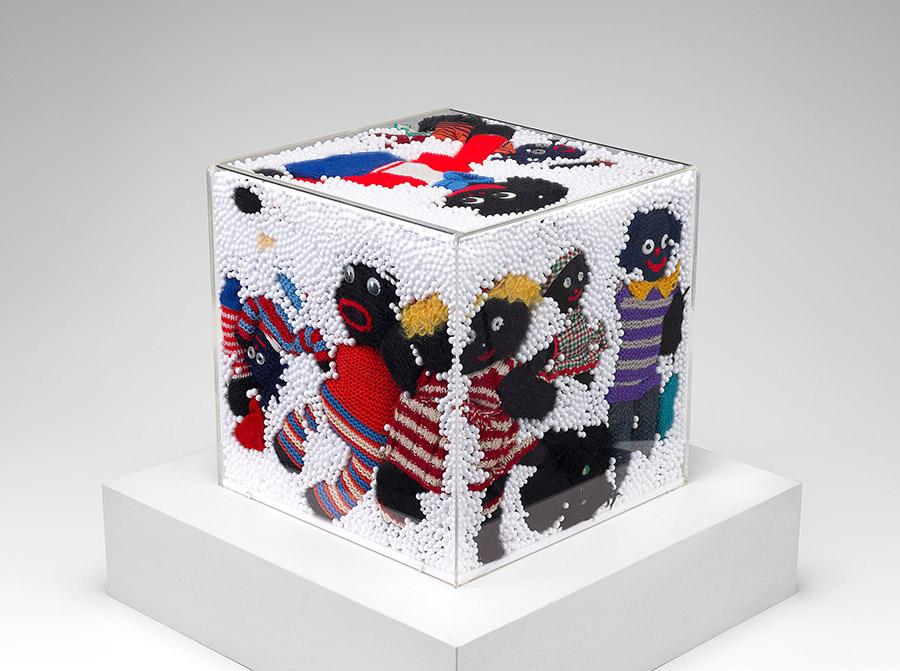Destiny Deacon Exhumes Australia’s Histories of Racism and Genocide
Tender yet brutal, Deacon's work melds violence and merriment at the NGV, Melbourne
Tender yet brutal, Deacon's work melds violence and merriment at the NGV, Melbourne

No one could have foreseen the concurrence of ‘DESTINY’ – a major retrospective of Indigenous Australian artist Destiny Deacon at the NGV, Melbourne – with the global protests against racial injustice that surged in the aftermath of the brutal killing of George Floyd in Minneapolis in May. But it’s apt. Both are crescendos of slow-burning anger at centuries of white supremacy and violence towards indigenous peoples, Black people and people of colour. While protesters have eagerly torn down confederate statues and monuments to British slave traders with unabashed rage, Deacon’s approach is more acerbic.
Born in Queensland and raised in Melbourne, Deacon’s ancestry hails from the Kuku people of far north Queensland and the Erub/Mer people of the Eastern Torres Strait, and her work fuses these legacies. Working principally with photography and installation, Deacon uses props to assemble scenarios full of puns and inversions, sly humour and semi-veiled cultural references.

Meloncholy, from the ‘Sad & Bad’ series (2000), depicts a decapitated black baby doll placed onto two halves of a watermelon set atop a gingham tablecloth. Her small body fits snugly into one scraped-out fruit, while her head rests precariously on the other, effecting a clash between the dismembered body and the candy-coloured picnic setting. The work riffs on the racist symbolism of the watermelon in the US while referencing Indigenous director Warwick Thornton’s film Sweet Country (2017), in which a child is beaten for stealing the fruit.
Tender yet brutal, these macabre works reflect an ever-present strategy in Deacon’s practice: a melding of violence and merriment that exhumes Australia’s histories of racism and genocide. Through her vast collection of vulgarized decorative objects – black dolls and boomerangs, tea towels and ashtrays – or what she refers to as ‘Koori kitsch’, Deacon shrewdly inverts the language of child’s play and make-believe to speak in veiled tongue of bloody massacre and the paternalistic polices of forced removal of Aboriginal and Torres Strait Islander children from their families and compulsory assimilation into white settler society as part of a federal campaign that ran from the 1910s to the 1970s, creating what is now known as the Stolen Generation. Many of Deacon’s images exude a tone of 1950s white conservatism – national flags, suburban life and Melbourne’s Moomba festivals that celebrate the federation’s anniversary – skewered by her subversive hand.

Her arsenal is comprised of word play and appropriation tactics. My boomerang did come back (2003) satirises the British comedian Charlie Drake’s 1961 racist popular song, ‘My Boomerang Won’t Come Back’, about a young Aboriginal man exiled from his tribe because of his unskilled use of the weapon. The triptych Blak lik mi (1991) includes blurry retakes of unauthorized 1960s reproductions printed on black velvet of two young naked Aboriginal women from Axel Poignant’s photo essay Piccaninny Walkabout (1957).
The casual racism of such cultural artefacts and the relentless way Indigenous peoples have been visually objectified are detourned through Deacon’s stylized images; not only through their stagy artifice but the genuinely arresting way in which the mute props speak.

The show’s centrepiece is Colour Blinded (2005), an installation made with Deacon’s long-time collaborator Virginia Fraser, featuring black and white photographs of posed dolls with dishevelled hair or dislocated limbs surrounding a series of Perspex cubes stuffed with golliwogs and polystyrene balls. The room is illuminated solely with low-pressure sodium lamps, flooding the space with an astringent yellow. Sucking the colour from every surface, the yellow haze reveals the imprisoned golliwogs, their bodies pressed mercilessly against their plastic encasing, drowning in a sea of tiny white balls.
The colonial gaze is most hauntingly captured in Whitey’s Watching (1994), a photograph of the iconic entrance to Melbourne’s historic amusement park, Luna Park. Shot at night, the re-printed polaroid shows the enormous plaster head in accentuated shadow, baring its distended row of eerily luminous teeth. Through her agile remodelling of culturally laden sources, Deacon re-appropriates that gaze. Destiny, or should we say ‘destiny’, stares back.
Main image: Destiny Deacon, Blak lik mi, 1991, LightJet print from Polaroid photograph, 80 x 100.0 cm. Courtesy: the artist and National Gallery of Victoria, Melbourne























